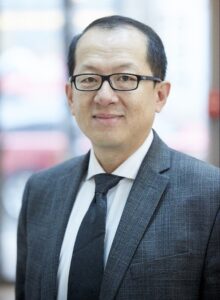 We’d like you to meet Dr. Qi Sun, Associate Professor in the Departments of Nutrition and Epidemiology. Below, we ask Qi about his research, academic career, and hobbies.
We’d like you to meet Dr. Qi Sun, Associate Professor in the Departments of Nutrition and Epidemiology. Below, we ask Qi about his research, academic career, and hobbies.
1. What research are you currently working on?
There are currently two exciting projects in my environmental epidemiology research space. I am collaborating with Antonia Calafat, Lanqing Wang, and Benjamin Blount at the US CDC to measure PAHs and HAAs, two groups of chemicals that may be generated through high temperature cooking of animal products, in urine samples collected in the POUNDS-Lost trial, Nurses’ Health Study II, and Coronary Artery Risk Development in Young Adults (CARDIA) Study. The goal of this project is to examine whether these chemicals may predict short-term and also long-term body weight changes in both intentional weight-loss setting and steady body weight setting. This project is supported by an NIEHS R01 grant which sponsored my research of environmental obesogens in human populations in the past 7 years. I am also leading a smaller but equally exciting and important project in the Nurses’ Health Study and Health Professionals Follow-up Study cohorts that aims to examine inter-relationships between PFASs exposures, blood lipoprotein and apolipoprotein profiles, and coronary heart disease risk. This project is based on my recent findings in the POUNDS-Lost trial that PFOA levels were associated with detrimental apolipoprotein C-III levels. Results from this project will hopefully serve as promising preliminary data for an R01 application. I consider myself very lucky that this project was chosen for funding by the Harvard Catalyst Pilot Study program.
2. What impact(s) do you hope this work will make?
I feel my research is, to certain degree, driven by scientific curiosity and also novelty. I hope that findings from my research bear scientific values and generate new knowledge, which subsequently can be used by anyone for making policy changes, guiding their own practices in daily life, or just simply knowing some facts. At the same time, I eventually realize that community awareness shall be one of the most important impacts that I hope my work can and shall make. I attended the 2019 National PFASs Conference and interacted with community representatives whose drinking water was contaminated by PFASs. I occasionally also received emails asking for advices from people whose life was ruined by PFASs contamination. Since then I feel responsible for, first of all, generating more evidence regarding PFASs’ detrimental effects on human health and also disseminating findings to more communities.
3. When you were first starting out, what inspired you to embark on this path of research? Do you have any tips for young investigators?
I have an atypical start of my path to environmental epidemiology. I was trained as a nutritional epidemiologist and am still doing nutritional epidemiology of cardiometabolic conditions. Ten years ago, Philippe Grandjean was interested in developing a grant proposal to evaluate persistent organic pollutants, including PFASs, in relation to diabetes risk in the Nurses’ Health Study cohorts. We worked together, as co-PIs, to write the grant, which was eventually funded by the NIEHS. This grant initiated my research in environmental epidemiology. I think this line of research is quite beneficial and rewarding to me since I can view research questions through different lens in different angles. If I have any tip for young investigators, I think that is to always dare to try new things! Of course, having a good mentor is always important.
4. How has our Center helped further your research? (i.e. have we funded studies, do you enjoy attending talks, networking with other Center members, etc.) How do you engage with our Center?
The Center helped further my research in many ways. I enjoyed the often inspiring seminars, through which I am constantly exposed to new methods, new ideas, and new development. I also benefited from the Center’s pilot grants. Interacting with other Center members is another perk. And this definitely fostered collaborations.
5. Outside of the academic space, what do you like to do for fun?
I enjoy watching good movies. I cannot help but mentioning that I love to read the Three-Body Problem. Each time I finished reading the books, I feel my ability to imagine is enhanced. I used to bike to the T and then take the T to work and loved this routine. But COVID-19 disrupted it. I look forward to resuming it when the pandemic eases off.
6. If you could be any dessert, what would it be and why?
It’s a tricky question for a nutritional epidemiologist! I think it would be a fruit dessert consisted of berries, grapes, pineapples, and yogurt.